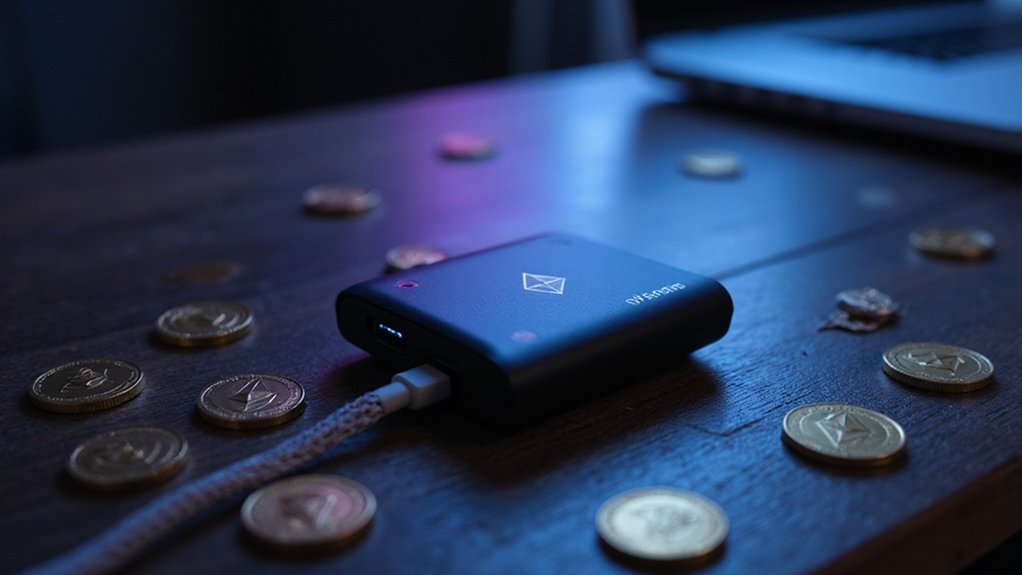“On-chain” transactions occur directly on the blockchain network itself, where every cryptocurrency transfer gets permanently recorded on the distributed ledger and validated through consensus mechanisms like Proof of Work or Proof of Stake. These operations prioritize security and transparency over speed, often incurring substantial fees (particularly on congested networks like Ethereum) while ensuring immutable, decentralized record-keeping. The architecture eliminates intermediaries but demands patience—and deeper wallets—for those seeking blockchain’s purest benefits.

Every cryptocurrency transaction faces a fundamental choice: remain transparently etched into the blockchain’s permanent record or venture into the murky waters of off-chain alternatives.
On-chain transactions represent the purest expression of blockchain technology’s foundational promise—immutable, decentralized record-keeping that operates without intermediaries. When cryptocurrency moves on-chain, the transaction broadcasts across the entire network, entering a mempool where it awaits validation by miners or validators operating under consensus mechanisms like Proof of Work or Proof of Stake. Once confirmed and added to a block, the transaction becomes permanently embedded in the blockchain’s distributed ledger, accessible to anyone with internet access and basic blockchain literacy.
On-chain transactions embody blockchain’s core promise: permanent, decentralized records validated through distributed consensus and accessible to all network participants.
This transparency comes with notable trade-offs that even the most ardent decentralization advocates acknowledge (albeit sometimes reluctantly). On-chain transactions typically require substantial fees paid to network validators, particularly on congested networks like Ethereum, where gas fees can occasionally exceed the value of smaller transactions—a peculiar economic phenomenon that highlights blockchain’s current limitations. Gas fee calculators have become indispensable tools for users seeking to estimate transaction costs accurately before executing transfers, enabling better financial planning and timing optimization.
Processing speeds lag considerably behind traditional payment systems, as network consensus requires time and computational resources that Visa’s centralized infrastructure simply doesn’t need.
The security architecture underlying on-chain transactions operates through cryptographic validation and distributed consensus, creating a trustless environment where transaction integrity doesn’t depend on institutional guarantees. Once recorded, on-chain data becomes practically immutable, protected by the computational power securing the entire network. This eliminates double-spending risks and fraudulent activities that plague centralized payment systems. By establishing true data ownership, users regain control over their financial information without relying on centralized institutions that historically monopolize and monetize personal data.
Smart contract executions, NFT transfers, and cryptocurrency movements all leverage on-chain infrastructure when maximum security and transparency take precedence over speed and cost efficiency. However, scalability constraints have prompted the development of layer-two solutions and off-chain alternatives that attempt to preserve blockchain benefits while addressing performance limitations. Payment channels enable instant transfers between parties through dedicated pathways that settle final balances on the main blockchain.
The fundamental tension between on-chain security and practical usability continues shaping cryptocurrency’s evolution. While off-chain solutions offer faster, cheaper transactions through external trust mechanisms, on-chain transactions maintain their position as the gold standard for transparency and decentralization—assuming users can tolerate the associated costs and delays inherent in truly decentralized systems.
Frequently Asked Questions
What Are the Typical Transaction Fees for On-Chain Cryptocurrency Transfers?
On-chain transaction fees vary dramatically across networks, reflecting each blockchain’s architectural compromises between security, speed, and cost.
Bitcoin typically charges $2-$10 per transaction during normal periods, though congestion can push fees beyond $30.
Ethereum’s gas fees swing wildly from under $1 to over $50, depending on network demand and smart contract complexity.
Meanwhile, newer blockchains like Solana maintain fees under $0.10, prioritizing throughput over decentralization—a trade-off that purists find troubling.
How Long Do On-Chain Transactions Usually Take to Confirm?
On-chain transaction confirmation times vary dramatically across blockchain networks, with Bitcoin requiring roughly 10 minutes for initial confirmation and up to an hour for full settlement (typically 6 confirmations).
Ethereum processes transactions within 2-6 minutes, while faster networks like Binance Smart Chain and Solana achieve confirmation in under two minutes.
However, these timeframes assume adequate transaction fees—a detail that becomes painfully relevant when low-fee transactions languish for hours or days.
Can On-Chain Transactions Be Reversed or Canceled After Submission?
On-chain transactions become irreversible once confirmed and embedded in a blockchain block—a feature that simultaneously represents cryptocurrency’s greatest strength and most unforgiving weakness.
While unconfirmed transactions lingering in the mempool can sometimes be canceled or replaced (through mechanisms like replace-by-fee), confirmed transactions achieve permanent immutability through cryptographic consensus.
This irreversibility demands meticulous verification before submission, as blockchain networks won’t accommodate second thoughts or fat-fingered wallet addresses.
Which Cryptocurrencies Support the Most On-Chain Transaction Volume?
Solana dominates on-chain transaction volume with 20-40 million daily transactions, dwarfing Ethereum’s respectable million-plus and BNB Smart Chain’s 5-10 million.
Bitcoin, despite its astronomical market cap, processes merely 200,000-300,000 transactions daily—proving that being first doesn’t guarantee being busiest.
Tron matches BSC’s range at 5-10 million transactions.
Solana’s impressive throughput (up to 3,000 TPS) and negligible fees create this volume disparity, though one wonders about actual economic significance versus mere activity.
Are On-Chain Transactions More Secure Than Off-Chain Alternatives?
On-chain transactions demonstrably offer superior security through immutable blockchain validation and decentralized consensus mechanisms, while off-chain alternatives sacrifice these robust guarantees for speed and cost efficiency.
The security differential becomes particularly pronounced when considering that altering on-chain records requires extraordinary computational resources, whereas off-chain systems introduce intermediary dependencies and trust assumptions.
For high-value transfers, the choice seems rather obvious—unless one enjoys unnecessary counterparty risk.









